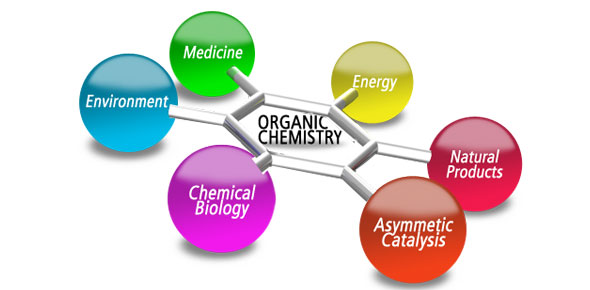Something Important About Organic Chemistry Quiz

A short quiz to test and reinforce your understanding on the topic of organic chemistry
- 1.
Why are large alkane molecules cracked to form smaller molecules?
- A.
Alkanes with large molecules are not useful.
- B.
Small alkane molecules can be polymerised.
- C.
Crude oil does not contain small alkane molecules.
- D.
To meet the demand for small alkane molecules.
Correct Answer
D. To meet the demand for small alkane molecules.Explanation
Large alkane molecules are not as useful as smaller molecules because they have limited applications. Cracking these large molecules into smaller ones allows for a greater variety of products to be made, which can meet the demand for small alkane molecules. This process is important in industries such as petrochemicals, where smaller molecules are used as feedstocks for the production of various chemicals and materials.Rate this question:
-
- 2.
Which fraction contains the largest molecules?
- A.
Kerosone
- B.
Petrol
- C.
Diesel
- D.
Bitumen
Correct Answer
D. BitumenExplanation
Bitumen contains the largest molecules among the given options. Bitumen is a highly viscous and sticky black or dark brown material that is commonly used in road construction. It is composed of complex hydrocarbon molecules with high molecular weights. These large molecules give bitumen its unique properties, such as high resistance to temperature variations and durability. In contrast, kerosene, petrol, and diesel have smaller and less complex molecules, making them more volatile and easier to ignite.Rate this question:
-
- 3.
Which statement about 'fossil fuel' is not true?
- A.
They all contain carbon.
- B.
They are renewable.
- C.
They produce pollutants when burnt.
- D.
They may cause acid rain.
Correct Answer
B. They are renewable.Explanation
The statement "They are renewable" is not true. Fossil fuels, such as coal, oil, and natural gas, are formed over millions of years from the remains of ancient plants and animals. Once they are depleted, they cannot be replenished within a human lifespan, making them non-renewable resources.Rate this question:
-
- 4.
Which of the following is not made from crude oil?
- A.
Aircraft fuel
- B.
Diesel oil
- C.
Furniture polish
- D.
Margarine
Correct Answer
D. MargarineExplanation
Margarine is not made from crude oil. Margarine is a spread made from vegetable oils, such as soybean, canola, or sunflower oil. It is produced through a process called hydrogenation, where the vegetable oils are transformed into a solid form. Crude oil is not used in the production of margarine. On the other hand, aircraft fuel, diesel oil, and furniture polish are all derived from crude oil.Rate this question:
-
- 5.
1. Write the molecular and condensed structural formula of a straight chain alkane with a) 6 carbon atoms b) 12 hydrogen atoms 2) Ethane is reacted with bromine under UV light. a) State the type of reaction which occurs. b) State the 3 stages of the type of reaction stated in (a). c) Write the chemical formula of all possible products formed in this reaction. 3) a) Write a chemical equation for the complete combustion of propane. b) If propane undergoes incomplete combustion, what are the possible products? 4) The relative molecular mass of propane, C3H8 and methanol, CH3OH are 44 and 32 respectively. Which substance would have a higher boiling point? Explain your answer.
Correct Answer
1. Write the molecular and condensed structural formula of a straight chain alkane with a) 6 carbon atoms C6H14- CH3CH2CH2CH2CH2CH3 b) 12 hydrogen atoms C5H12- CH3CH2CH2CH2CH3 2) Ethane is reacted with bromine under UV light. a) State the type of reaction which occurs. Free Radical Substitution b) State the 3 stages of the type of reaction stated in (a). Initiation, Propagation, Termination c) Write the chemical formula of all possible products formed in this reaction. C2H5Br, C2H4Br2, C2H3Br3, C2H2Br4, C2HBr5, C2Br6, HBr, Br2 3) a) Write a chemical equation for the complete combustion of propane. C3H8 + 5O2 3CO2 + 4H2O b) If propane undergoes incomplete combustion, what are the possible products? C3H8 + O2 carbon, carbon monoxide, carbon dioxide, water 4) The relative molecular mass of propane, C3H8 and methanol, CH3OH are 44 and 32 respectively. Which substance would have a higher boiling point? Explain your answer. Methanol. Propane is an alkane and the intermolecular force present is the induced dipole-induced dipole force which is weak. Methanol is an alcohol and the intermolecular force present is the dipole-dipole force resulting from the formation of hydrogen bonds which is much stronger. Therefore more energy is required to overcome the intermolecular forces holding the molecules together in methanol than in propane and hence methanol has a higher boiling point.Explanation
The boiling point of a substance is determined by the strength of its intermolecular forces. Methanol, being an alcohol, has stronger intermolecular forces compared to propane, which is an alkane. Methanol can form hydrogen bonds between its molecules, resulting in stronger attractions. Propane, on the other hand, only has induced dipole-induced dipole forces, which are weaker. Therefore, methanol requires more energy to break the intermolecular forces and transition from a liquid to a gas, resulting in a higher boiling point compared to propane.Rate this question:
Quiz Review Timeline +
Our quizzes are rigorously reviewed, monitored and continuously updated by our expert board to maintain accuracy, relevance, and timeliness.
-
Current Version
-
Mar 20, 2023Quiz Edited by
ProProfs Editorial Team -
Aug 18, 2010Quiz Created by
SamuelTay4p223
- Atom Quizzes
- Atomic Theory Quizzes
- Chemical Bonding Quizzes
- Chemical Compound Quizzes
- Chemical Element Quizzes
- Chemistry Practice Quizzes
- Clinical Chemistry Quizzes
- Electrolysis Quizzes
- Gas Quizzes
- General Chemistry Quizzes
- IBSL Chemistry Quizzes
- Medicinal Chemistry Quizzes
- Molecule Quizzes
- Periodic Table Quizzes
- Rate Of Reaction Quizzes
- Reaction Quizzes
- Soap Quizzes
- Solution And Mixture Quizzes
- State Of Matter Quizzes
- Stoichiometry Quizzes
 Back to top
Back to top


